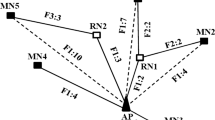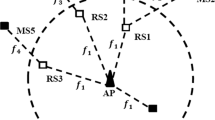Abstract
In this paper, we study the hand-off performance of a wireless system with heterogeneous technologies called iCAR (Integrated Cellular and Ad hoc Relaying). In iCAR, hand-offs can occur not only from a Base Transceiver Station (BTS) to another BTS, but also from a BTS to a so-called Ad hoc Relaying Station (ARS) in the form of relaying, as well as from an ARS back to a BTS. The latter two types of hand-offs effectively increase the hand-off buffer time and thus reduce the call dropping probability. We develop an analytical model for the hand-off performance in iCAR. In addition, we verify the analytical model via simulations and quantify the hand-off performance benefits of the iCAR system over conventional cellular systems. It is anticipated that the analytical and simulation models reported in this paper will serve as a guideline to other researches on the inter-system hand-off involving heterogenous wireless technologies.
Similar content being viewed by others
References
I. Akyildiz, W. Su, Y. Sankarasubramaniam and E. Cayirci, Wireless sensor networks: A survey, Computer Networks 38 (2002) 393–422.
R. Bagrodia, R. Meyer, M. Takai, Y. Chen, X. Zeng, J. Martin, B. Park and H. Song, Parsec: A parallel simulation environment for complex systems, Computer (Oct. 1998) 77–85.
V. Bharghavan, A. Demers, S. Shenker and L. Zhang, MACAW: A media access protocol for wireless LANs, in: Proceedings, 1994 SIGCOMM Conference, London, UK (1994) 212–225.
L. Chen, H. Murata, S. Yoshida and S. Hirose, Wireless dynamic channel assignment performance under packet data traffic, IEEE Journal on Selected Areas in Communications 17(7) (1999) 1257–1269.
S. Das, R. Castaneda, J. Yan and R. Sengupta, Comparative performance evaluation of routing protocols for mobile ad hoc networks, in: 7th Int. Conf. on Computer Communications and Networks (IC3N) (1998) pp. 153–161.
S.K. Das, S.K. Sen and R. Jayaram, A dynamic load balancing strategy for channel assignment using selective borrowing in cellular mobile environment, in: Mobile Computing and Networking (1996) 73–84.
H. Ebersman and O.K. Tonguz, Handoff ordering using signal prediction priority queueing in personal communication systems, IEEE Transactions on Vehicular Technology 48(1) (1999) 20–35.
Y. Fang and I. Chlamtac, Teletraffic analysis and mobility modeling for pcs networks, IEEE Transactions on Communications 47(7) 1999 1062–1072.
Y. Fang and I. Chlamtac, Analytical generalized results for the handoff probability in wireless networks, IEEE Transactions on Communications 50(3) (2002) 396–399.
A. Gamst, Study of radio network design stategies, in: IEEE Vehicular Technology Conference 36th (1986) 319–328.
V. Garg and J. Wilkes, Wireless and Personal Communications Systems (Prentice Hall, 1996).
J.D. Gibson, The Mobile Communications Handbook (CRC Press, Inc., 1996).
J. Haartsen, M. Naghshineh, J. Inouye, O. Joeressen and W. Allen, Bluetooth: Vision, goals, and architecture, Mobile Computing and Communications Review 2 (1998) 38–45.
H. Holma and A. Toskala, WCDMA For UMTS (John Wiley & Sons, 2000) p. 44.
D. Hong and S.S. Rappaport, Traffic model and performance analysis for cellular mobile radio telephone systems with prioritized and no-protection handoff procedure, IEEE Transactions on Vehicular Technology 3 (1986) 77–92.
V. MacDonald, The cellular concept, The Bell System Technical Journal 58(1) (1978) 15–43.
A. Nasipuri, J. Zhuang and S.R. Das, A multichannel csma mac protocol for multihop wireless networks, in: Proceedings of the IEEE Wireless Communications and Networking Conference (WCNC) (September, 1999).
K. Negus, A. Stephens and L. Jim, HomeRF: Wireless networking for the connected home, IEEE Personal Communications 6 (2000) 20–27.
T. Neubauer and E. Bonek, Smart-antenna space-time umts uplink processing for system capacity enhancement, in: Advances in UMTS Technology, Hermes Penton Inc (2002) 126–145.
S. Rappaport, Blocking, handoff and traffic performance for cellular communication systems with mixed platforms, IEE Proceedings 140(5) (1993) 389–401.
T. Rappaport, Wireless Communications Principle and Practice (Prentice Hall, 1996).
H. Salgado, M. Sirbu and J. Peha, Spectrum sharing through dynamic channel assignment for open access to personal communications services, in: IEEE International Communications Conference (ICC) (1995) 417–422.
C. C. Shen, C. Srisathapornphat and C. Jaikaeo, Sensor information networking architecture and applications, IEEE Personal Communications, 8(4) (2001) 52–59.
K. Sivarajan, R. McEliece and J. Ketchum, Dynamic channel assignment in cellular radio, in: IEEE Vehicular Technology Conference (VTC) (1990) 631–637.
G. Stuber, Principles of Mobile Communication (Kluwer Academic Publishers, 1996).
A. Viterbi, CDMA Principles of Spread Spectrum Communication (Addison-Wesley, 1996).
H. Wu, C. Qiao and S. Dixit, Signaling and routing protocols in icar (integrated cellular and ad hoc relaying system), in: Wireless IP, Artech House, (2002) ch. 21, pp. 441–455.
H. Wu and C. Qiao, Modeling iCAR via Multi-dimensional Markov Chains, ACM Mobile Networking and Applications (MONET), Special Issue on Performance Evaluation of Qos Architectures in Mobile Networks 8(3) (2003) 295–306.
H. Wu, C. Qiao, S. De and O. Tonguz, Integrated cellular and ad-hoc relay systems: iCAR, IEEE Journal on Selected Areas in Communications special issue on Mobility and Resource Management in Next Generation Wireless System 19(10) (2001) 2105–2115. Edited by Ian F. Akyildiz, David Goodman and Leonard Kleinrock.
A. Xhafa and O.K. Tonguz, Dynamic priority queuing in personal communication systems: An analytical framework for performance evaluation, in: Proc. of the 10th IEEE International Symposium on Personal, Indoor, and Mobile Radio Communications (PIMRC'99)(1999) pp. 1346–1350.
X. Zeng, R. Bagrodia and M. Gerla, GloMoSim: A library for parallel simulation of large-scale wireless networks, in: Proc. Workshop on Parallel and Distributed Simulation (1998) pp. 154–161.
Author information
Authors and Affiliations
Additional information
This research is in part supported by NSF under the contract ANIR-ITR 0082916.
Hongyi Wu is currently a tenure-track Assistant Professor at The Center for Advanced Computer Studies (CACS), University of Louisiana (UL) at Lafayette. He received his Ph.D degree in Computer Science from State University of New York (SUNY) at Buffalo in 2002. He received his M.S. degree from SUNY at Buffalo in 2000 and B.S. degree from Zhejiang University in 1996, respectively. He worked in Nokia Research Center in the summers of 2001 and 2000. His research interests include wireless mobile ad hoc networks, sensor networks, the next generation cellular systems, and the integrated heterogeneous wireless systems. He has served as the symposium chair, the session chair, and the technical committee member of several IEEE conferences, and the guest editor of ACM MONET special issue on Integration of Heterogeneous Wireless Technologies. He has published about two dozens of technical papers in leading journals and conference proceedings, as well as a book chapter.
Swades De received his B.Tech degree in Radiophysics and Electronics from University of Calcutta, India, in 1993, M.Tech degree in Optoelectronics and Optical Communication from Indian Institute of Technology, Delhi, in 1998, and Ph.D degree in Electrical Engineering from State University of New York at Buffalo in 2004. During 1993-1997 he was a hardware development engineer and during the first half of 1999 he was a software engineer with different telecommunication companies in India. During first half of 2004, he was with the Istituto di Scienza e Technologie dell' Informazione, National Research Council (ISTI-CNR), Pisa, Italy, theough a European research fellowship. He is currently an Assistant Professor in the Department of Electrical and Computer Engineering, New Jersey Institute of Technology, Newark, NJ, USA. His His research interests include performance study, resource efficiency in multihop wireless and wireline networks, integrated wireless technologies, and communication and systems issues in optical networks.
Dr. Chunming Qiao directs the Lab for Advanced Network Design, Analysis, and Research,(LANDER, which conducts cutting-edge research work on optical networks, wireless networks, survivable networks, and TCP/IP technologies. He has published more than one hundred twenty papers in leading technical journals and conference proceedings. His pioneering research on Optical Internet, in particular, the optical burst switching (OBS) paradigm is internationally acclaimed. In addition, his work on integrated cellular and ad hoc relaying systems (iCAR) is recognized as the harbinger for today's push towards the convergence between heterogeneous wireless technologies, and has been featured in Businessweek and Wireless Europe.
Dr. Qiao have given several keynotes, tutorials and invited talks on the above research topics. He is on the editorial board of several journals and magazines including IEEE/ACM Transactions on Networking (ToN), and IEEE Communications Magazine, and have guest-edited several IEEE JSAC and ACM/Baltzer issues. He has chaired and co-chaired a dozen of international conferences and workshops including the High-Speed Networking Workshop (formerly GBN) at Infocom'01 and Infocom'02, Opticomm'02, and the symposium on Optical Networks at ICC'03.
Evsen Yanmaz was born in Ankara, Turkey, in 1979. She received the B.S. degree in electrical and electronics engineering from Bogaziçi University, Istanbul, Turkey, in 2000, and the M.S. degree in electrical engineering from the State University of New York (SUNY) at Buffalo, Amherst, NY, in 2002. Currently, she is working toward the Ph.D. degree in electrical and computer engineering at Carnegie Mellon University, Pittsburgh, PA.
From 2000 to 2002, she was a Research and Teaching Assistant at SUNY at Buffalo. Since 2002, she has been a Research Assistant at Carnegie Mellon University, where she has been working on congestion in cellular communication systems and dynamic load balancing schemes. Her current research interests are in resource allocation and congestion relief in heterogeneous wireless networks.
Ozan K. Tonguz was born in Cyprus, in May 1960. He received the B.Sc. degree from the University of Essex, England, in 1980, and the M.Sc. and the Ph.D. degrees from Rutgers University, New Brunswick, NJ, in 1986 and 1990, respectively, all in electrical engineering.
He is currently a tenured Full Professor in the Department of Electrical and Computer Engineering at Carnegie Mellon University (CMU). Before joining CMU in August 2000, he was with the ECE Dept. of the State University of New York at Buffalo (SUNY/Buffalo). He joined SUNY/Buffalo in 1990 as an Assistant Professor, where he was granted early tenure and promoted to Associate Professor in 1995, and to Full Professor in 1998. Prior to joining academia, he was with Bell Communications Research (Bellcore) between 1988–1990 doing research in optical networks and communication systems. His current research interests are in optical networks, wireless networks and communication systems, high-speed networking, and satellite communications. He has published in the areas of optical networks, wireless communications and networks, and high-speed networking. Author or coauthor of more than 150 technical papers in IEEE journals and conference proceedings, and a book chapter (Wiley, 1999), his contributions in optical networks and wireless networks are internationally acclaimed. His industrial experience includes periods with Bell Communications Research, CTI Inc., Harris RF Communications, Aria Wireless Systems, Clearwire Technologies, Nokia Networks, and Asea Brown Boveri (ABB). He currently serves as a consultant for several companies, law firms, and government agencies in USA and Europe in the broad area of telecommunications and networking. He is also a Co-Director (Thrust Leader) of the Center for Wireless and Broadband Networking Research at Carnegie Mellon University.
In addition to serving on the Technical Program Committees of several IEEE conferences and symposia in the area of wireless communications and optical networks, Dr. Tonguz currently serves or has served as an Associate Editor for the IEEE TRANSACTIONS ON COMMUNICATIONS, IEEE COMMUNICATIONS MAGAZINE, and IEEE JOURNAL OF LIGHTWAVE TECHNOLOGY. He was a Guest Editor of the special issue of the IEEE JOURNAL OF LIGHTWAVE TECHNOLOGY AND IEEE JOURNAL ON SELECTED AREAS IN COMMUNICATIONS on Multiwavelength Optical Networks and Technology, published in 1996.
Rights and permissions
About this article
Cite this article
Wu, H., De, S., Qiao, C. et al. Hand-Off Performance of the Integrated Cellular and Ad Hoc Relaying (iCAR) System. Wireless Netw 11, 775–785 (2005). https://doi.org/10.1007/s11276-005-3530-9
Issue Date:
DOI: https://doi.org/10.1007/s11276-005-3530-9




